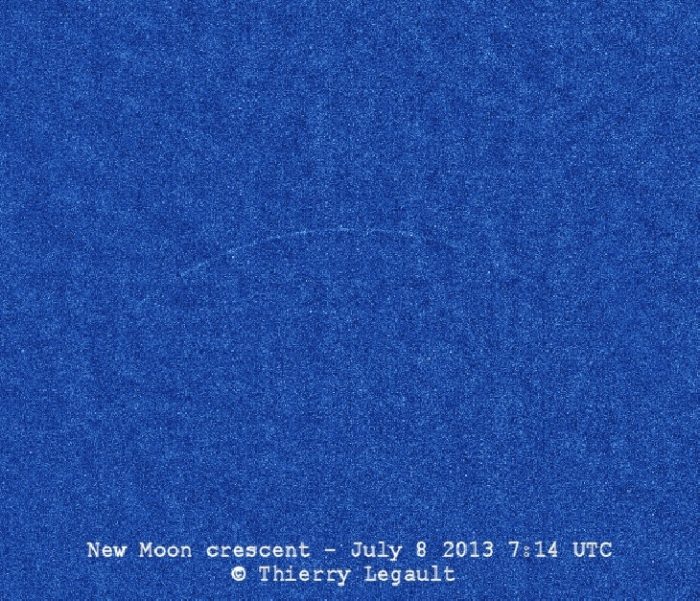

Youngest possible lunar crescent, with the moon’s age being exactly zero when this photo was taken — at the instant of new moon – 07:14 UTC on July 8, 2013. Image by Thierry Legault.
A moon at the new phase comes most nearly – for any particular month – to passing between the Earth and sun. New moon is May 15, 2018 at 11:48 UTC; translate UTC to your time.
New moons come once each month, as the moon orbits Earth. On the day of new moon – unless we’re viewing a total solar eclipse – we don’t see the new moon. That’s because a new moon rises when the sun rises. It sets when the sun sets. It crosses the sky with the sun during the day. Its fully illuminated face, or day side, is turned entirely away from us.
It’s only as the moon moves in orbit, as its lighted hemisphere begins to come into view from Earth, that we can see it in our sky. Then we see the moon in the west after sunset as a slim waxing crescent – what some call a young moon.
This month’s new moon marks the start of the Islamic holy month of Ramadan. Read more: When does Ramadan begin in 2018?
Bottom line: As the moon orbits Earth, it changes phase in an orderly way. New moon comes on May 15 at 11:48 UTC.
Four keys to understanding moon phases
from EarthSky https://ift.tt/19T9DUm


Youngest possible lunar crescent, with the moon’s age being exactly zero when this photo was taken — at the instant of new moon – 07:14 UTC on July 8, 2013. Image by Thierry Legault.
A moon at the new phase comes most nearly – for any particular month – to passing between the Earth and sun. New moon is May 15, 2018 at 11:48 UTC; translate UTC to your time.
New moons come once each month, as the moon orbits Earth. On the day of new moon – unless we’re viewing a total solar eclipse – we don’t see the new moon. That’s because a new moon rises when the sun rises. It sets when the sun sets. It crosses the sky with the sun during the day. Its fully illuminated face, or day side, is turned entirely away from us.
It’s only as the moon moves in orbit, as its lighted hemisphere begins to come into view from Earth, that we can see it in our sky. Then we see the moon in the west after sunset as a slim waxing crescent – what some call a young moon.
This month’s new moon marks the start of the Islamic holy month of Ramadan. Read more: When does Ramadan begin in 2018?
Bottom line: As the moon orbits Earth, it changes phase in an orderly way. New moon comes on May 15 at 11:48 UTC.
Four keys to understanding moon phases
from EarthSky https://ift.tt/19T9DUm

Aucun commentaire:
Enregistrer un commentaire